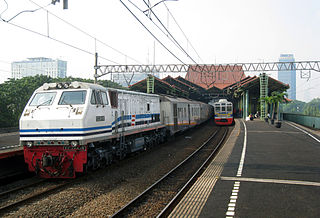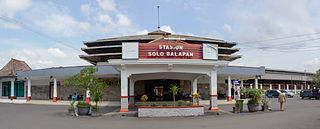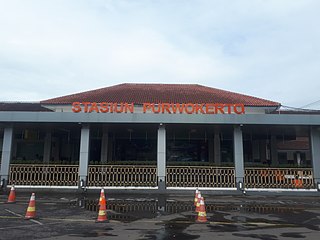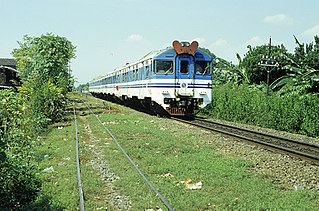
The majority of Indonesia's railways are on Java, used for both passenger and freight transport. There are three noncontinuous railway networks in Sumatra with two new networks are being developed in Kalimantan and Sulawesi. Indonesia has finalized its plan for a national railway network recently. According to the plan, 3,200 km of train tracks that will criss-cross the islands of Sumatra, Java, Kalimantan, and Sulawesi, it has been touted as the most extensive railway project in Indonesia since its independence from the Dutch in 1945.

KRL Commuterline, or commonly known as Commuterline or KRL by Indonesians, is a commuter rail system for Greater Jakarta in Indonesia. It was previously known as KRL Jabodetabek.

The Ambarawa Railway Museum, is a museum located in Ambarawa in Central Java, Indonesia. The museum focuses on the collection of steam locomotives, the remains of the closing of the 3 ft 6 in (1,067 mm) railway line.

Bandung Station or Hall Station is the largest train station in Bandung and, perhaps, in the West Java province. It is where "Operation Area 2" is which surrounds the area of Bandung and Priangan.

The GE U20C diesel-electric locomotive was introduced by GE Transportation Systems as an export model road switcher in 1964. It was powered by the 8-cylinder 7FDL-8 engine. This locomotive is used worldwide with many variations and modifications. Different engines may be used, e.g. 7FDL8 and 7FDL12. Like the other members of the Universal series, and can be built to suit all track gauges.
PT Industri Kereta Api (Persero), abbreviated as INKA, is a rolling stock manufacturer. It is completely owned by the Government of Indonesia.

Bojonegoro Station is the largest railway station in Sukorejo, Bojonegoro, Bojonegoro Regency, East Java. The station is owned and operated by PT Kereta Api Indonesia.

Argo Bromo Anggrek is the name of executive-class train jointly operated by Kereta Api Indonesia between Surabaya and Jakarta in Indonesia. The train covers 725 kilometres in 9 hours along Java's north coast, stopping at Bojonegoro, Semarang Tawang, Pekalongan, and Cirebon.

Solo Balapan Station, is major railway station in City of Surakarta. The name "Balapan" is taken from the name of a village which is located to the north of the station. The station is located on the railway line that connects the cities of Bandung, Jakarta, Surabaya, and Semarang. Solo Balapan Station is the largest station in the City of Surakarta and Central Java.

Indonesia's first – and historic Southeast Asia's first – high-speed rail (HSR) project was expected to connect the national capital Jakarta with Bandung in neighboring West Java province, covering a distance of over 140 kilometres. Plans and studies have been in the works for high-speed rail (HSR) in Indonesia around for many years. However, it was not until 2008 that it was contemplated seriously. The new plan to finally start HSR construction was announced by Indonesian Government in July 2015, after President of China and world leaders visited Bandung Conference. Plans were also mentioned for a possible extension of the HSR to Surabaya in East Java. The first phase (Jakarta-Bandung) is planned to be completed by 2021 for trial, and begin its commercial operation in 2022.
Most railway lines in Indonesia were constructed during the Dutch colonial rule. After independence in 1945, many lines were abandoned. The current national rail operator, PT Kereta Api Indonesia (Persero), was founded on 28 September 1945.

The EMD GT38ACe diesel-electric locomotives are made by Electro-Motive Diesel for export in Indonesia. There are 55 locomotives owned by the state-owned Indonesian Railway Company, all of them are for in Sumatra and replace the aging EMD G26. It's also one of two most advanced-technology locomotive in Indonesia.

The GE CM20EMP diesel-electric locomotives are owned by PT Kereta Api and built by GE Rail. The GE CM20EMPs are multipurpose locomotives, not only for hauling passenger trains, but also freight trains.

Argo Jati is a train service operated by Indonesian Railway Company between Jakarta and Cirebon in Java, Indonesia. This train was relaunched on November 3, 2010 as a replacement train series of Argo Jati, which was launched in 2007.
The Trans-Sulawesi Railway, is a railway network under construction in the Indonesian island of Sulawesi. The construction is divided to three phases.

Purwokerto Station (PWT) is a large railway station located in West Purwokerto, Banyumas Regency, Central Java, Indonesia.

Kualanamu Airport Railink Services (ARS) is an airport rail link service in North Sumatra, Indonesia. These airport rail link is built to cut travel time from Medan city center to the airport, as roads connecting the Kualanamu International Airport and Medan city center are frequently affected by traffic congestion.

Argo Parahyangan, also commonly known as GOPAR is an executive class train operated by Indonesian Railway Company between Gambir railway station, Jakarta and Bandung or Kiaracondong in Java, Indonesia. The train covers 166 kilometres in 3 hours. From Jakarta to Bandung the train has stoppage at Bekasi, Cimahi, and Purwakarta, where as from Bandung to Jakarta it stops only at Jatinegara. KAI operates 34 trips daily in the route.

Prambanan Express, commonly abbreviated as Pramex and Prameks is a commuter rail service that operates in Solo, Yogyakarta, and Purworejo Regency of Java island in Indonesia. It is a mainstay of public transport for the community in these three cities. The train service is popular among daily commuters as well as tourists who visit this area known as center for Javanese culture and heritage.

Argo Wilis is an executive class train operated by PT Kereta Api Indonesia between Surabaya and Jakarta in Java, Indonesia. The train covers 865 kilometers in 17 hours with stoppage at Bandung, Cipeundeuy, Tasikmalaya, Banjar, Kroya, Kutoarjo, Yogyakarta, Solo Balapan, Madiun, and Jombang. This train runs in the morning from Gambir to Surabaya Gubeng or vice versa, and arrives at the destination at night. In the journey Gambir to Surabaya, passengers can enjoy the beautiful panorama of the eastern part of Parahyangan mountainous region.





















